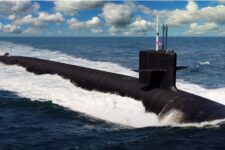 Adm. Jonathan Greenert is Chief of Naval Operations, the Navy’s most senior officer. Greenert has emphasized the convergence between traditional electronic warfare — long a strong suit of the Navy — and the new arena of cyberspace. In this op-ed written for Breaking Defense, the admiral argues that “cyberspace and the electromagnetic spectrum” must be viewed as a single domain of warfare on par with land, sea, air, and space. Click here to read more from Greenert’s chief cyber aide, Rear Adm. William Leigher. — The Editors.
Adm. Jonathan Greenert is Chief of Naval Operations, the Navy’s most senior officer. Greenert has emphasized the convergence between traditional electronic warfare — long a strong suit of the Navy — and the new arena of cyberspace. In this op-ed written for Breaking Defense, the admiral argues that “cyberspace and the electromagnetic spectrum” must be viewed as a single domain of warfare on par with land, sea, air, and space. Click here to read more from Greenert’s chief cyber aide, Rear Adm. William Leigher. — The Editors.
An unmanned aircraft is returning to its ship when it suddenly loses control, plummeting 5,000 feet to the water and shattering on contact with the surface. Halfway around the world, the lighting at an airfield in North America flickers several times before finally going dark, forcing airliners to seek out an alternate airport to land. In a windowless control room, system administrators at a large international corporation are alerted to higher than normal internet traffic on their servers: Before they can intervene, files which hold the key to a new cancer-fighting drug are exfiltrated via the company’s wireless network, placing 10 years of research and more than a billion dollars of investment at risk. These kinds of events, although uncommon, do happen – and they arise from our dependence on the electromagnetic (EM) spectrum.
The electromagnetic spectrum is an essential – and invisible – part of modern life. We unlock our car and control our television with remote controls, routinely communicate using smart phones, and avoid automobile or aircraft collisions with any number of electronic sensors. EM transmissions and cyberspace are also essential to modern warfare. Our military forces use wireless computer networks to coordinate operations and order supplies, use radars and sensors to locate each other and the enemy, and use electronic jammers to blind enemy radars or disrupt their communications.
With wireless routers or satellites part of almost every computer network, cyberspace and the EM spectrum now form one continuous environment. This environment is so fundamental to naval operations, and so critical to our national interests, that we must treat it on par with our traditional domains of land, sea, air, and space. In fact, future conflicts will not be won simply by using the EM spectrum and cyberspace, they will be won within the EM spectrum and cyberspace. This will require changes to our operating concepts, military systems and – most importantly – a new way of thinking in our Navy.
From primitive tool to double-edged sword
Our use of the electromagnetic spectrum has changed dramatically since Heinrich Hertz discovered it in 1888. Right away, EM transmissions were used to communicate with ships at sea. But in 1922, Naval Research Laboratory scientists also used radio waves to detect a moving ship, creating radio detection and ranging, or radar. With war raging in Europe and East Asia, in 1939 the new technology was sent to USS New York for testing and experimentation. Based on the successful results, radars were soon installed throughout the fleet and became pivotal to winning the war at sea.
Since World War II, the military pioneered new uses for the EM spectrum, from satellite navigation and radar jammers to short-range wireless networks and infrared missile seekers. Now computer processors and transmitters are inherent in almost all our shipboard equipment, and even mechanical systems such as gas turbine engines and guns are “on the grid.”
The EM spectrum is also an integral part of our military and civilian computer networks. Just like in our homes or in a Starbucks, a wireless network provides mobility. We can keep far-flung forces, aircraft and ships connected with each other and commanders back home, but wireless systems also provide ways to access a network that is otherwise isolated from the wider internet. Navy forces have a unique opportunity to exploit (or be exploited by) this access because of their presence around the world and ability to closely approach opponents via the sea.
Commanding the electromagnetic and cyber environment
America’s key military advantage for the last twenty years has been our ability to sense and create a picture of our surroundings, then use that picture to control the air, sea, and undersea domains. The systems that build our operational picture have performed well in the relatively unchallenged EM environments of Iraq and Afghanistan, but in future conflicts that will not be the case.
Inexpensive jammers, signal detectors, computer processors and radios make it easier for unfriendly states, terrorists, and criminals to manage their efforts while jamming our own ability to sense and communicate. Meanwhile, the number of users in the EM spectrum has grown dramatically over the last two decades. The result is an environment we struggle to sense, understand and use in warfare. We need a concerted effort to harness the EM and cyber environment to give us a warfighting edge.
First, we will improve our awareness of the EM and cyber environments. We will detect and assess in real time what is happening in the EM and cyber environment, predict how the environment will react and use this knowledge to guide our own actions. Building this level of awareness will be challenging. Our tools for collecting and analyzing information in the EM and cyber environment are limited, and we lack the familiarity and understanding to take full advantage of the information we do have. To build better tools for sensing the EM and cyber environment, we will work closely with industry and academic researchers.
Second, we will employ agility in the EM spectrum and cyberspace. This will reduce our vulnerability to detection and maximize our ability to defeat jamming and deception. If our systems can shift frequency over a wide range, use shorter “burst” transmissions, employ small directional beams, or move applications between servers automatically in response to a sensed anomaly, our EM and cyber operations would be less predictable, harder to classify, and more difficult to counter or disrupt. One example of this is our “Integrated Topside” project, which uses modular, reconfigurable antennas in a ship’s superstructure that can be alternatively employed as radars, listening devices, or radios.
Finally, we will change how we view the role of EM and cyber in warfare. EM and cyber systems and operators won’t just support air, land, and space operations as they did in previous conflicts. Aircraft and ships will instead help get our EM and cyber capabilities into the fight. This will require developing the same “real-time” flexibility in planning and executing EM and cyber operations as we have today in the traditional “physical” domains.
Warfare in the EM spectrum and cyberspace is much more challenging than in other domains such as undersea or in the open ocean. The web and spectrum are crowded with civilian and commercial users who are rapidly developing and fielding new technologies. To take the high ground in this new environment, we will have to work with industry and fundamentally change our approach to operations and warfare. Most importantly, we will leverage those strengths that are impossible to reverse-engineer: the expertise and flexibility of our research base, our history of adaptation, and the skill and perseverance of our Sailors.
Anduril’s Aussie drone sub ‘one year early and on budget,’ heads to production
Defense Industry Minister Pat Conroy said Anduril’s Ghost Shark is part of the Australian military’s $5.2 billion to $7.2 billion investment in undersea uncrewed maritime systems.


























